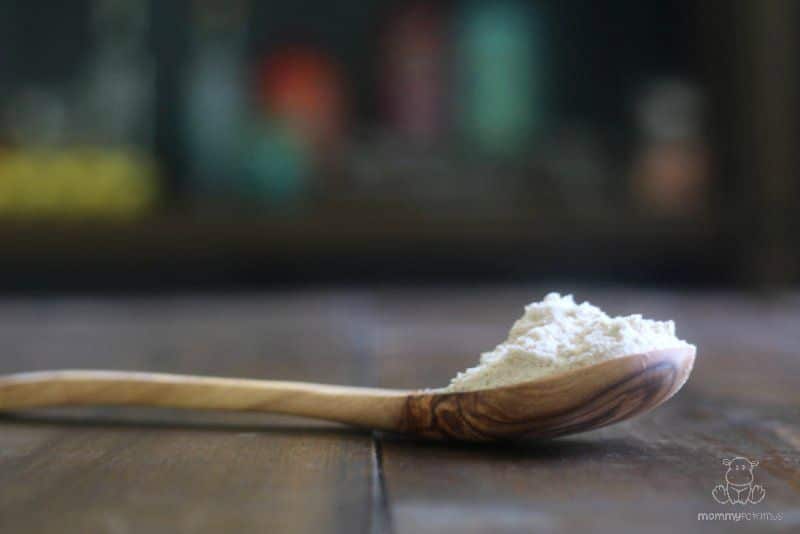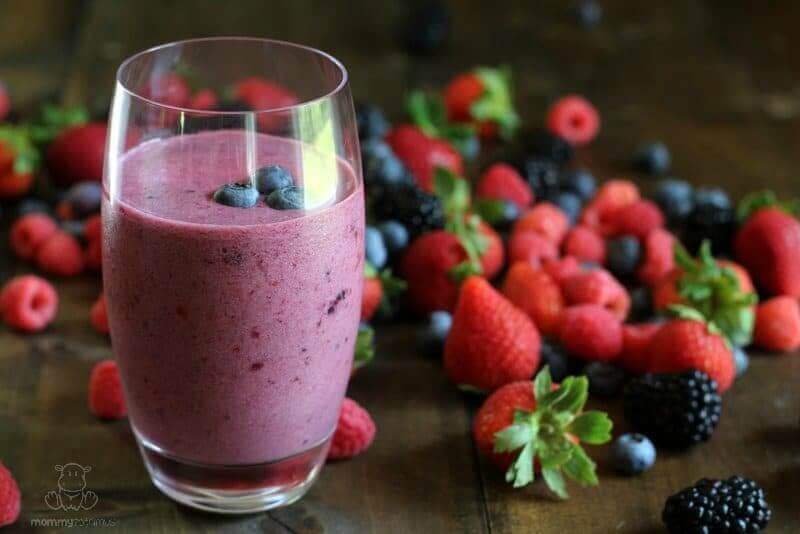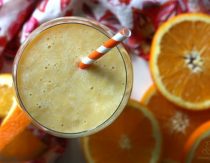“Table for one trillion, please.” It may seem like a funny way to request a spot at your favorite healthy restaurant, but it’s actually pretty accurate.
In this New York Times article, Michael Pollan describes the one trillion, er, one-hundred trillion, microbes that sit down to dine with us at each meal. More than just creepy freeloaders, these guys have a profound impact on our health – maybe even more than genetics. Here’s how Pollan explains it:
for every human cell that is intrinsic to our body, there are about 10 resident microbes — including commensals (generally harmless freeloaders) and mutualists (favor traders) and, in only a tiny number of cases, pathogens.
To the extent that we are bearers of genetic information, more than 99 percent of it is microbial. And it appears increasingly likely that this ‘second genome,’ as it is sometimes called, exerts an influence on our health as great and possibly even greater than the genes we inherit from our parents. But while your inherited genes are more or less fixed, it may be possible to reshape, even cultivate, your second genome.”
Although the ratio of human to bacterial cells in the human body has recently been revised – the estimate is that we’re about 50/50 – the fact remains that the microbes we carry with us exert a huge influence on our health, and even on our emotions.
Unfortunately, modern life has not been kind to this second genome – often called our microbiome. Factors like processed foods, the overuse of antibiotics, environmental toxins and less time spent outdoors have drastically reduced the diversity of microbes we carry.

Resistant Starch And Weight Loss
“Disorders in our internal ecosystem — a loss of diversity, say, or a proliferation of the ‘wrong’ kind of microbes — may predispose us to obesity and a whole range of chronic diseases, as well as some infections.” – Michael Pollan, Some of My Best Friends Are Germs
Now it’s easy to gloss over this and think “yeah, yeah, lots of factors go into metabolism.” That’s true, but get this: In this study, researchers “took two groups of mice whose digestive tracts had been sterilized. In the first group, they colonized the mice’s intestines with flora from an obese cage mate. In the second group, they colonized the intestines with flora from a lean mouse. They then fed these two groups of mice the same diet for 2 weeks.” (source)
The mice who received the microbes from the obese mouse gained more weight, despite comparable food intake and intake levels.
Other studies have demonstrated that microbes implanted from lean mice into overweight mice caused the mice to lose weight. To me, this research is not really about weight loss or gain, but rather a reminder that our lifestyle choices are impacted by the health of our internal microbiome.
So how do we encourage a diverse microbiome?
By serving up hearty meals for our one-hundred trillion, of course! According to Stanford microbiologist Justin Sonnenburg, “The safest way to increase your microbial biodiversity is to eat a variety of polysaccharides.” (source)
In case you are wondering, that’s smart guy speak for the things that nourish our gut bacteria – inulin, fiber and resistant starch for example. Now, you already know what fiber is and you may have heard of inulin, but chances are you are asking yourself . . .
What is resistant starch?
Unlike probiotics, which are beneficial bacteria that we take internally through supplementation or fermented foods, resistant starch is a prebiotic – or food for our bacteria.
Dr. Amy Nett explains it this way:
Prebiotics are indigestible carbohydrates, or at least indigestible to us, that reach the colon intact and selectively feed many strains of beneficial bacteria. Prebiotics are generally classified into three different types: non-starch polysaccharides (such as inulin and fructooligosaccharide), soluble fiber (including psyllium husk and acacia fibers), and resistant starch (RS). Each of these types of prebiotics feeds different species of gut bacteria, but among these, RS is emerging as uniquely beneficial.” (source)
When beneficial bacteria feed on resistant starch, they produce short-chain fatty acids such as butyrate, which help to increase metabolism, decrease inflammation and improve stress resistance. (source)
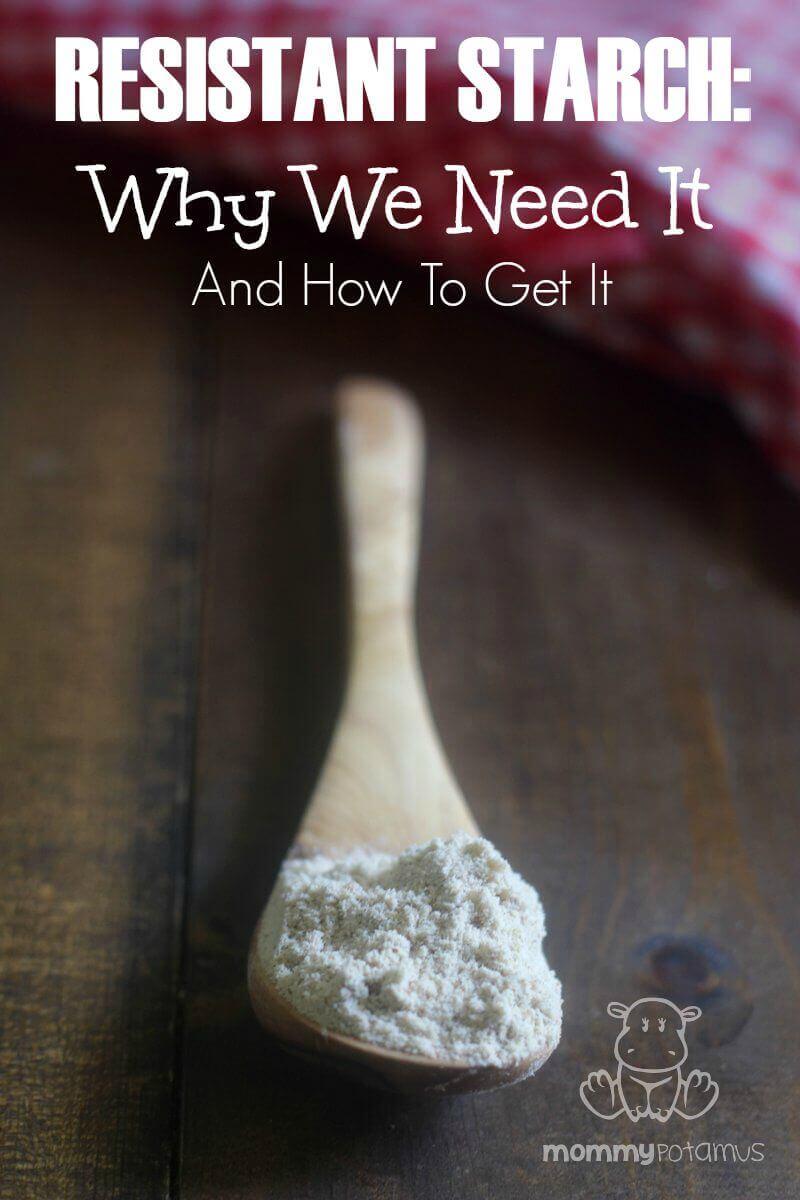
What’s the best source of resistant starch?
Bacteria have favorite foods just like we do, so I incorporate a variety of resistant starches to nourish different populations. There are three naturally occurring types:
Type 1 RS is “physically inaccessible, bound within the fibrous cell walls of plants. This is found in grains, seeds, and legumes.” (source)
Type 2 RS is “Starch with a high amylose content, which is indigestible in the raw state. This is found in potatoes, green (unripe) bananas, and plantains. Cooking these foods causes changes in the starch making it digestible to us, and removing the resistant starch.” (source) Tigernuts also belong to this category. They’re very sweet and can be eaten as a snack whole, or ground into a flour to make no-bake cookies with – my kids LOVE these resistant starch cookie dough bites. For info on the brand I use, check out the Pantry Staples section on this page.
Note: We don’t eat raw potatoes, but raw potato starch (not flour) can be consumed in smoothies. However, even after cooking potatoes there’s still a way to benefit from the resistant starch they contain. More info in the next paragraph.
Type 3 RS is “Also called retrograde RS since this type of RS forms after Type 1 or Type 2 RS is cooked and then cooled. These cooked and cooled foods can be reheated at low temperatures, less than 130 degrees and maintain the benefits of RS (6). Heating at higher temperatures will again convert the starch into a form that is digestible to us rather than ‘feeding’ our gut bacteria. Examples include cooked and cooled parboiled rice, cooked and cooled potatoes, and cooked and cooled properly prepared (soaked or sprouted) legumes.” (source)
To recap, some whole-food forms of resistant starch are:
- Cooked and cooled potatoes
- Cooked and cooled beans
- Cooked and cooled rice
- Tigernuts (eaten whole) or tigernut flour
- Yams
- Raw tapioca starch
- Uncooked oats
- Green bananas (often tossed into smoothies or dehydrated into chips)
- Raw green banana flour (made from whole green bananas that have been dried and ground into flour)
Can I just throw a bit of potato starch into a smoothie? That seems easiest
Since resistant starch hit the nutrition scene, recommendations to consume isolated forms of it like potato or tapioca starch have become very popular. This is understandable: throwing a spoonful of starch into a smoothie or in your oatmeal is super easy.
However, although there are times when it may be appropriate to incorporate isolated forms of resistant starch, here are a few points worth considering:
- Research shows that too much isolated resistant starch can throw off our gut population (source)
- Many of the research-supported benefits of resistant starch, including decreased insulin resistance and reduced cancer risk, have only been shown when the resistant starch is mixed with other forms of soluble fiber – aka whole-food form. (source)
- Different beneficial bacteria prefer different forms of resistant starch. For example, lactobacilli and bifidobacteria aren’t big fans of potato starch. They like beans and bananas. (source)
- The RS3 form of resistant starch (cooked and cooled potatoes, rice and beans, etc.) ferments more slowly in the gut. The fact that it takes longer to break down means that more of it arrives intact in the large intestine, where the majority of our bacteria live.
- Consuming a variety of prebiotics in whole-food form is the best approach to supporting a thriving and diverse microbiome. See the bottom of this post for recipes to get you started.
How do I incorporate resistant starch?
In my kitchen, the preferred sources of resistant starch are cold potato salad with homemade mayo, tigernut flour cookies, rice and bean salad, dehydrated green banana chips, and smoothies made with green bananas or plantains – sometimes with an additional resistant starch flour added in. (Options are tigernut flour, green banana flour, plantain flour, and organic potato starch.)
We take care to vary the sources so that we don’t overfeed any particular population, and we include both soluble and insoluble fiber from lightly cooked, raw or fermented vegetables. Research suggests it works synergistically with resistant starch to encourage a diverse microbiome, and is especially important to include with RS2 starch found in green bananas, plantains and raw potatoes.
Of course, I also include high quality probiotics (you can find info on the two I take here) and fermented foods to increase the number good guys in my gut.
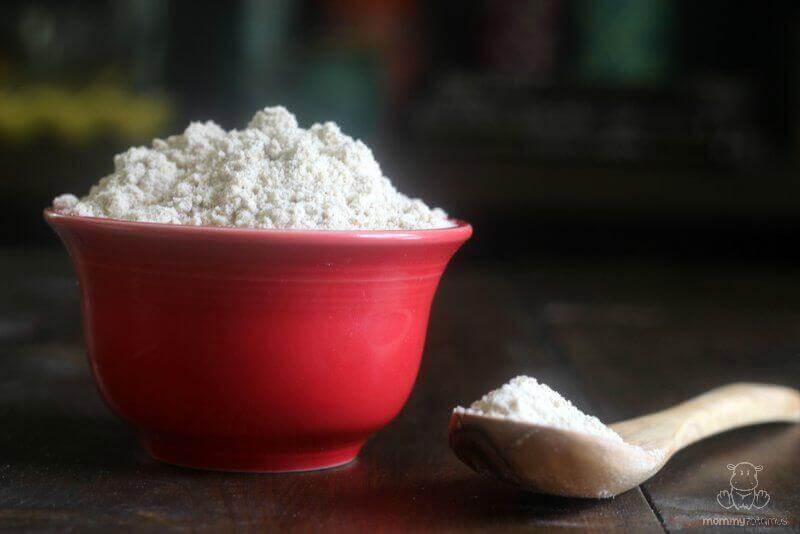
Is resistant starch compatible with a gut healing diet?
Several gut healing protocols restrict intake of resistant starch. The goal in doing so is to rebalance the gut microbiome before giving it lots of food to feast on – that way, the resistant starch nourishes a wide variety of beneficial gut bacteria.
This is often the approach taken with small intestine bacterial overgrowth (SIBO), which is exactly what it sounds like – an overgrowth of normal bacteria or the presence of pathogenic bacteria in the small intestine. The goal in restricting resistant starch is to starve the bacteria, however some practitioners have found that supplementing with resistant starch improves SIBO in some cases. (source)
Like most things, there’s probably not a one-size-fits-all approach that will work for everyone. Here’s what I mean:
A traditional Inuit family eats a day’s worth of food consisting of raw and cooked seafood and fermented foods. Basically, they ate a 0% starch diet and most of their calories came from fat. But they are famous for their lack of chronic diseases like tooth decay, heart attacks, cancer and diabetes. So, that must mean that carbohydrate is unnecessary for good health and might actually be one of the reasons our western populations are so sick right?
Well, let’s take a peek at the meals of a Tukisenta family. The majority of the meal is carbohydrate, mostly starch from sweet potatoes. At an average of 94.6% carbohydrate, it would appear they follow the opposite approach of the Inuit. And yet they have great health, too. This group of people destroys the simple argument that carbohydrate from starch are inherently bad or disease causing.” Steven Wright, SCD Lifestyle
Bottom line: We’re all biologically unique. Maybe it makes sense for some people to incorporate resistant starch into a SIBO or autoimmune protocol, while for others it won’t. It’s important to listen to our bodies and make adjustments as needed.
That said, if restricting resistant starch seems like the best approach, it’s important to remember that gut healing diets are meant to be temporary. Long-term avoidance of resistant starch – and other fermentable forms of fiber – appears to have a negative impact on the gut microbiome. In other words, starving gut bacteria can be beneficial when trying to kill off pathogenic populations and replenish them with beneficial ones. However, starving them on an ongoing basis appears to result in a a less robust microbiome.
How much resistant starch should I eat?
According to Dr. Amy Nett, “Studies indicate that the benefits of resistant starch may be seen when consuming around 15 to 30 grams daily (equivalent to two to four tablespoons of potato starch). This may be too much for some people to tolerate, particularly in the setting of gut dysbiosis, and going above this amount is not necessarily beneficial.” (source)
If using potato starch, he recommends starting with about 1/4 teaspoon and working your way up if it’s well-tolerated. Because my family incorporates whole food forms of resistant starch into our meals, I didn’t worry about measuring the exact amount each of us was eating. Instead, I just served small portions at first and increased our intake as long as we didn’t experience any digestive issues. (We didn’t except for once when we ate WAY too many resistant starch cookie dough bites.)
Tips for incorporating resistant starch into your diet
- Start slow and work your way up. If you experience bloating or digestive discomfort, reduce your intake for a few days and then try again. “If you experience marked GI distress with even small amounts of RS, this may be an indication of SIBO (small intestinal bacterial overgrowth) or microbial dysbiosis, and you may need to consider working with a healthcare practitioner to establish a more balanced gut microbiome through the use of herbal antimicrobials and probiotics before adding RS or other prebiotics,” writes Dr. Nett.
- Make sure and consume fermented foods and/or probiotics along with resistant starch. It’s not necessary to always consume them at the same time, but it’s important to populate the gut with good bacteria while also providing food that helps them thrive.
Resistant Starch Recipes
- Bacon & Ranch Potato Salad
- Southwestern Rice & Bean Salad (recipe coming soon)
- Potato Salad With Bacon & Egg (recipe coming soon)
- Resistant Starch Cookie Dough Bites
- Very Berry Resistant Starch Smoothie
- Resistant Starch Black Bean Dip
- Resistant Starch Strawberry Smoothie
- Hummus
Want to tell a friend about the benefits of resistant starch?
Share this article by pressing one of the links below!

